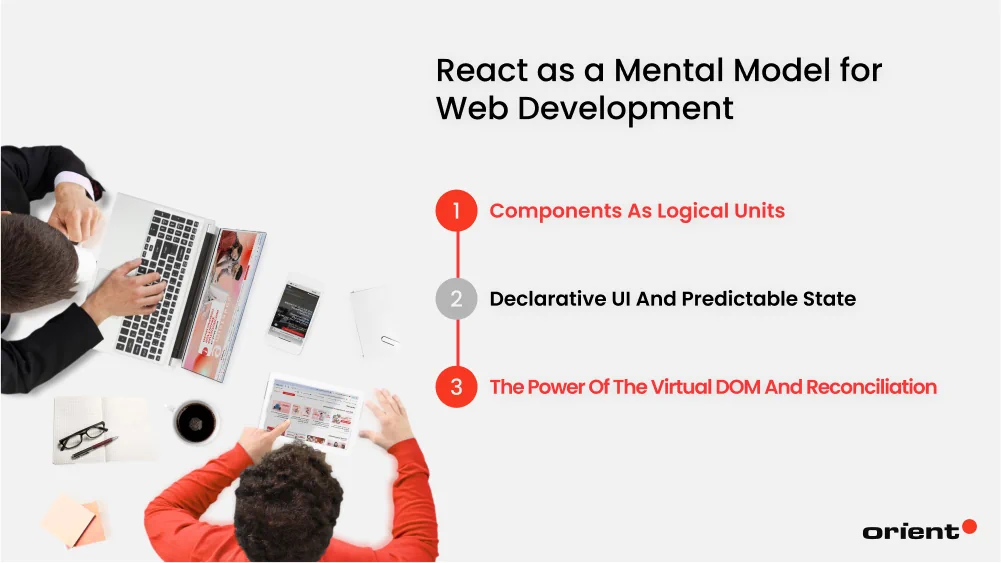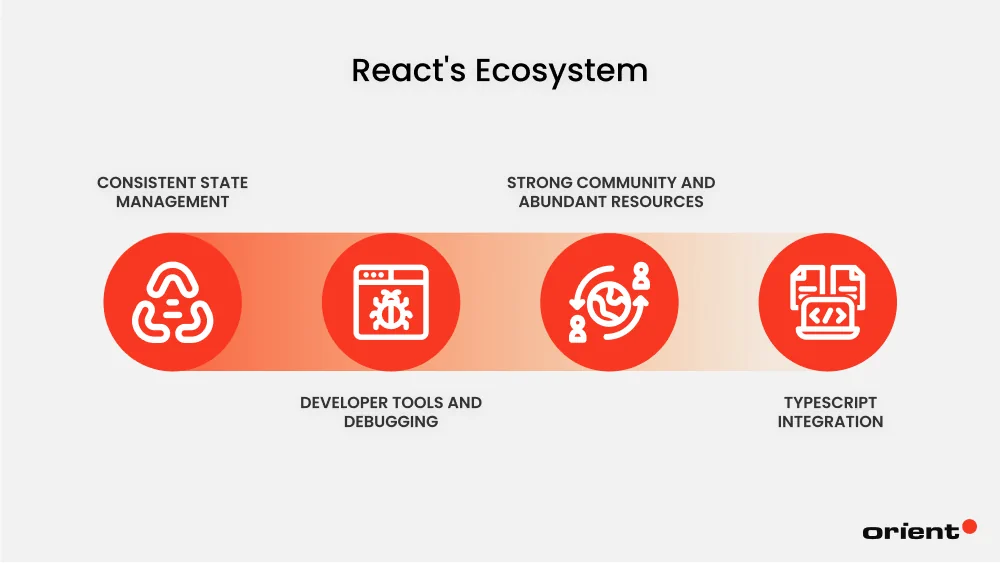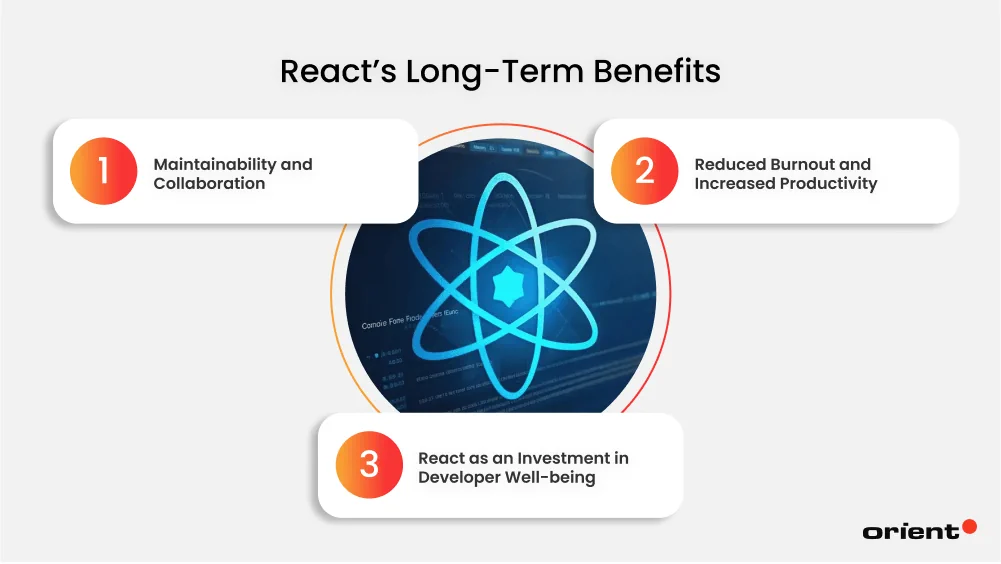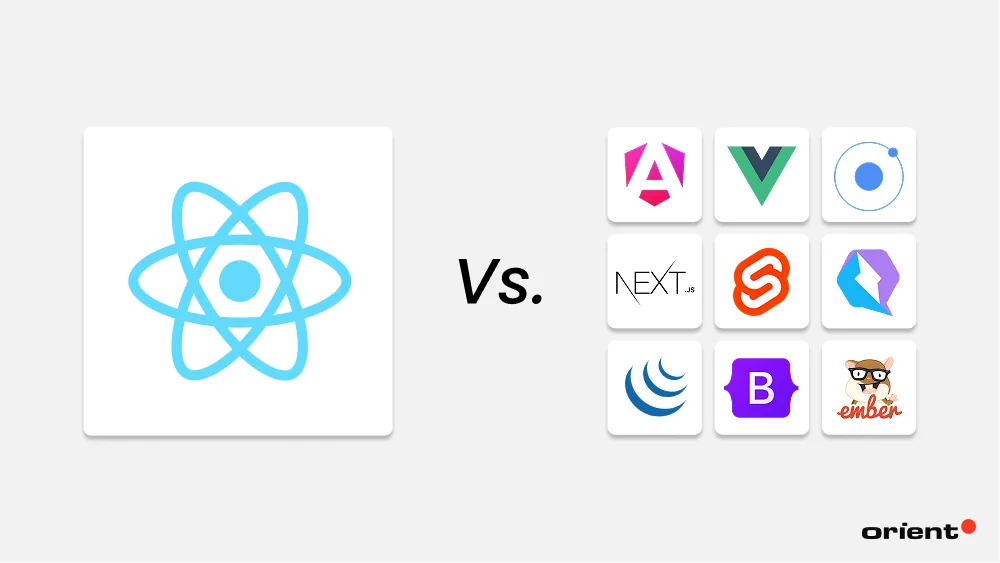
Why Use React? To Reclaim Developers’ Joy in Complex Web Development
React restores developer happiness during complex web development with its component-based and declarative methodology. The ecosystem of tools, together with the community and its debugging features, along with state management solutions, minimize complexity and make development less taxing. Choose React to experience a productive development approach that lowers stress during development work.

Content Map
More chaptersNumerical data provides strong evidence of the widespread acceptance of React. Based on the 2024 Stack Overflow Developer Survey, React.js continues to stay among the most popular front-end libraries by being adopted by a substantial portion of professional developers. The State of JavaScript 2023 report indicates that developers are highly satisfied with React, so a large share of them plan to keep using this framework. Moreover, the adoption of React across various industries will reach new heights through the confirmed utilization of more than 1.3 million websites in 2024.
Why use React? The web development experience transforms based on the tools developers use for building interactive interfaces while maintaining high performance standards. React has established itself as the leading front-end choice to deliver intense pleasure in developing complex web applications due to both its technical excellence and user-friendly development model.
The following examines the fundamental advantages that developers gain when they choose React as their web development solution. We will explain how the core principles alongside an active ecosystem enhance developer efficiency while creating sustainable and enjoyable development practices.
The Age of Web Complexity
The web is no longer a simple collection of static pages displaying basic information. Today, modern applications are sophisticated ecosystems powered by microservices architectures, complex state management, and highly interactive user interfaces (UIs). Businesses need perfectly integrated dynamic services that support users on all platforms and devices, which forces developers to create complex processing systems for real-time data handling.
The technical execution of complicated systems produces negative impacts on developer productivity along with reduced work-related happiness. Many developers need to continuously solve complex logic problems as well as identify hard-to-find performance issues while handling decentralized dependencies. Developers must fight an endless battle against state management problems together with unpredictable rendering behavior and data synchronization issues, which lead to much more error-fixing work than innovation.
Many developers encounter burnout due to this repetitive process, which transforms coding from their stimulating work into a draining chore.
In an era where complexity threatens to overshadow creativity, React serves developers as a productivity catalyst because it reclaims creative problem-solving while reducing frustrations during complex times. This begs the question: What is React used for that allows it to achieve this balance? When to use React? These questions will become clearer when considering the following advantages offered by this framework.
React as a Mental Model for Web Development
React delivers an elegant mental model that developers can use to structure and reason about complex web applications.

Components as Logical Units
The core architectural premise of React relies on its component-based architecture rather than treating applications like one big block of HTML, CSS, and JavaScript by enabling developers to split the user interface into organized reusable components. The individual units called React components contain their own business logic and display functions along with possible state management capabilities for operation as independent tools. The particular level of detail permits users to process information more efficiently. The developer can work on understanding and creating individual components independently without handling all application structures and systems at once.
Consider a social media feed: Instead of managing posts, comments, and reactions globally, React allows you to define discrete components like Posts, Comments, and Reactions. Each functions independently, making it easier to maintain, debug, and extend functionality without affecting other parts of the UI.
React development becomes easier for developers when applications are properly organized. A properly defined component hierarchy enables developers to find problems specifically within single components instead of forcing them to analyze the whole application code.
Declarative UI and Predictable State
UI development within React follows a declaration-based programming paradigm. Through declarative approaches, developers specify how the DOM’s appearance should change based on current data instead of providing step-by-step guidance for DOM manipulation (imperative approach). React will transform the desired state into an updated DOM that reflects the user interface requirements. A declarative structure creates an easier way to reason about state modifications. The developer merely provides details about how the UI should appear after new data updates. Working with React allows developers to skip time-consuming DOM manipulation tracking, which imperative development requires.
Take the case of a toggle button as an illustration.
- The imperative approach demands specific event handlers that modify DOM elements by changing their styles and attributes upon user clicks.
- In React’s declarative syntax, the state variable “isToggled” controls the button appearance while React performs automatic UI updates based on state changes.
The declarative state management mechanism provides developers with predictable outcomes because it eliminates unexpected problems frequently encountered in imperative programming methods. Less debugging time occurs because the state transitions lie exclusively within central management rather than dispersing across various event handlers.
The Power of the Virtual DOM and Reconciliation
The Virtual DOM and its efficient reconciliation algorithm used by React build another essential abstraction layer, which eases developers’ workload. React maintains an efficient in-memory model of the UI, which serves as an alternative to browsing the browser’s actual DOM structure. React performs state changes on the DOM by running calculations for minimum necessary updates through a mechanism called reconciliation. The application updates only specific parts of the interface, which requires refreshing instead of causing all elements to re-render simultaneously.
The developer does not need to manage these complex processes because they operate automatically in the background. They only need to specify desired UI states in component render methods, knowing React will handle efficient DOM modification.
Imagine rendering a product catalog where a user applies filters:
- Without optimization, filtering might cause the entire catalog to update, leading to sluggish performance.
- React’s virtual DOM ensures that only filtered items are re-rendered, avoiding expensive DOM operations.
Developers receive complete freedom from DOM optimization duties through abstraction, which results in decreased stress and enhanced development efficiency.
These technical advantages offered by React directly translate into significant long-term maintainability benefits for large-scale applications. Less time is “lost” in deciphering complex and poorly structured code or in extensive refactoring efforts. Feature releases can be rolled out more quickly and with greater confidence, as the codebase is easier to adapt and extend. Furthermore, the well-defined structure and clear principles of React make it significantly easier to onboard new developers to a project, allowing them to quickly understand the codebase and contribute effectively, ultimately boosting team productivity and reducing the learning curve associated with complex applications.
React’s Ecosystem: Tools for Sanity
Beyond its core architectural principles, the strong and established framework of React provides developers with various effective tools that improve both development management and reduce development pressure.

Consistent State Management
Complex web application development requires stronger state management of user interface data because applications grow in both features and user base. When state updates remain uncoordinated, applications become hard for developers to understand their data flow dynamics, and developers struggle both with cryptic faults and rising workloads to track state movements across the application structure. The React ecosystem provides multiple state management solutions, of which Redux and Context API represent two main approaches.
Redux operates with a single centralized application store that regulates data updates through a single-directional pattern. The application triggers actions to reducers, which serve as predictable functions that update the store, and subscribers monitor specific store sections for data changes. This intentional state management design streamlines state monitoring since developers understand every data transformation step by step.
The Context API assists developers in sharing application-wide data through its lightweight architecture, which eliminates the requirement for prop drilling. The predictable patterns within these tools, along with their state control mechanisms, stop developers from dealing with difficult-to-debug state management code chaos and achieve greater sanity in complex development projects.
Developer Tools and Debugging
Developers frequently encounter vast amounts of discomfort when they need to debug intricate UI interactions alongside complex component structures. React addresses this issue through the React DevTools browser extension, which provides powerful and easy-to-use developer tools. This tool provides developers with essential tools to see component trees while checking props and states immediately and following data flow through components. The unexpected behaviors of UI elements become easily identifiable through React DevTools because developers gain insight into the exact responsible component while viewing its current state along with its received props.
Through its toolset, the DevTools generates performance information that enables developers to create performance profiles that expose bottlenecks. Programming systems designed for React include various debugging instruments like error boundary elements, which stop application crashes and generate descriptive error messages, together with complex monitoring and logging capabilities. Debugging resources make the otherwise difficult-to-decipher bug-searching process into an observable process, which reduces debugging time while eliminating difficult UI troubleshooting problems.
Strong Community and Abundant Resources
Software development includes fundamental factors together with hard-to-detect bugs as unavoidable elements. React provides developers with much-needed support to face these challenges that would otherwise leave them alone in their development challenges. Web development professionals maintain the React ecosystem as one of the biggest and most engaged developer communities in the field today. Thousands of developers maintain this extensive network that develops various online resources, which include thorough documentation alongside detailed tutorials, the Stack Overflow discussion platform, and numerous educational videos and content pieces.
If a developer faces a coding issue, there is a high probability that a previous developer has encountered the same challenge with available solutions found in the community. A multitude of developers offering ready assistance reduces both the emotional isolation felt when encountering unfamiliar issues and the duration of time needed to overcome them.
TypeScript Integration
Large and complex projects gain additional sanity benefits from React development when developers leverage TypeScript as a statically typed JavaScript superset. React components and their props obtain static typing in TypeScript; thus, developers can discover errors in development and prevent runtime browser bugs before execution. Proactive error detection via TypeScript makes system malfunctions less likely while helping developers focus on debugging more easily.
Explicit type annotations in TypeScript serve to create automated documentation, which decreases the difficulty developers face when understanding codebase expectations. TypeScript provides increased predictability to developers through its code, which gives them confidence they will observe the expected results in execution.
The current IDEs that incorporate TypeScript leverage its robust auto-completion together with code navigation capabilities, which help developers reduce their brainpower usage when they need to access API information and explore big code repositories. The integration of TypeScript creates a stable development environment for React developers because it detects errors early and improves code understanding, which results in better tools for developers to work with.
React’s Long-Term Benefits of Developer Sanity
The use of React provides development teams with long-lasting advantages that mutually benefit both their well-being and productivity and deliver substantial results to their organizations.

Maintainability and Collaboration
A well-structured React code base offers benefits in present development work while creating an environment that is friendly for new development projects. Through its self-contained component structure, React enables developers to keep UI functionality sections organized for easy reuse across different projects.
- Code Reusability: The ability to reuse React components throughout different application areas results in two benefits: a reduction of duplicate code and a lower possibility of inconsistent results.
- Modularity: Breaking UI elements into separate modular components enables team members to maintain their work areas independently, thus preventing disruptions.
- Scalability: When the project demands expansion, developers can introduce new features via existing code without any rewrite operations to achieve sustainability.
Additionally, tools such as Storybook offers teams a solution to document and share UI components, which strengthens large team collaboration efficiency. The structured design of the ecosystem lets developers maintain an efficient workflow that results in more sustainable outcomes.
Reduced Burnout and Increased Productivity
Developer burnout occurs when teams work in unorganized codebases while applying mixed development methods and dedicate continuous time to fire suppression efforts. Through its defined patterns and documentation, React delivers development predictability, which helps resolve this issue.
Key factors reducing burnout:
- Clear state management: The use of state management libraries such as Redux and Zustand prevent state-related confusion, which lowers mental workload.
- Powerful debugging tools: The combination of React DevTools and ESLint gives developers strong debugging capabilities that detect problems in advance, thereby reducing project frustration.
- Strong typing with TypeScript: TypeScript static type checking enables developers to detect runtime issues during development, which helps smooth debugging processes.
Users who work with React can stay motivated because the platform eliminates standard challenges that developers must resolve, so their main focus remains on addressing issues instead of fixing bugs. Reduced workplace burnout enables the retention of personnel, which helps companies retain their developers who experience lower turnover rates and minimize expenses from new employee support and performance drops.
React as an Investment in Developer Well-being
The choice of a technology stack isn’t just about technical capabilities—it impacts the long-term health of the development team. React provides a stable, well-supported foundation that promotes sustainable coding practices.
- Less technical debt: The use of structured React code reduces technical debt by cutting down unnecessary complexity, which means your development team avoids long-term difficulties.
- Smooth updates and expansions: React ensures continuous development because it maintains backward compatibility, which results in unbroken updates and expansions.
- Continuous improvements: The active React developer community maintains an ongoing expansion of features, which ensures that developers have access to current technological answers.
When organizations make developer welfare a priority, they get better employee performance alongside improved collective morale along with economic advantages that extend over time.
React vs. Other Frameworks: Why It Stands Out

The contemporary web development environment provides several attractive front-end frameworks, such as Vue, Angular, and Svelte, yet React stands out due to its distinct combination of architectural decisions and developer philosophy, which helps create a superior development experience specifically for complex applications within its large ecosystem.
The three main competitors to React include Vue, Angular, and Svelte. These frameworks each offer distinct characteristics.
- The Vue.js framework functions with reactive components similar to React while offering stricter architectural restrictions in its framework structure. The two-way data binding in Vue simplifies specific user interface operations, yet React offers better state management predictability through its unidirectional data flow system for large applications.
- Angular delivers a complete framework along with mandatory architectural norms while providing features that include dependency injection tools and form validation components. Angular provides excellent capabilities for enterprise applications, yet its complicated learning paths surpass those of React’s approach, which is more user-friendly.
- The compilation process in Svelte removes the virtual DOM and boosts performance by providing an optimized system. Svelte results in lightweight applications, but developers face fewer development resources since React’s community size remains smaller than that of React’s extensive resources available to developers.
While Vue, Angular, and Svelte each have compelling advantages, React’s flexibility, declarative nature, and strong ecosystem make it an unparalleled choice for scalable and developer-friendly applications. What makes React truly stand out is its minimalistic yet scalable nature, allowing developers to build anything from small applications to large-scale projects without being locked into rigid frameworks.
Prioritizing Developer Experience for Long-Term Success
The primary performance benefits of React as a front-end tool extend beyond its efficiency capabilities. Thanks to its structured component system and professional developer tools (such as React DevTools), together with its extensive, helpful community base, React offers an exceptional development process. React provides developers the ability to transform complex interfaces into manageable components that are reusable, and this capability enhances developer control while lowering user confusion. The wealth of ecosystem solutions solves standard development problems, which lets engineers build application logic without creating new code from scratch.
React serves as more than a UI rendering performance engine because developers should view it as an entire software environment that places priority on clarity alongside empowerment and prediction. This focus on developer experience translates into more productive teams, lower rates of burnout, and ultimately, higher quality software delivered more efficiently.
The React platform delivers an ideal solution to organizations that need stable web applications with a strong focus on their staff’s well-being and productivity. Our expertise at Orient Software extends to the maximum utilization of React/React Native frameworks and their companion ecosystem when developing exceptional web/mobile applications. We grasp how to focus on building rich user interfaces using React and execute state management optimally and sustainably to maintain applications in the long run. Contact Orient Software when seeking dependable assistance to execute your React-based web development initiatives. Our team at Orient Software will guide you through React development initiatives to create innovative applications together with a beneficial and productive development process for your team.






